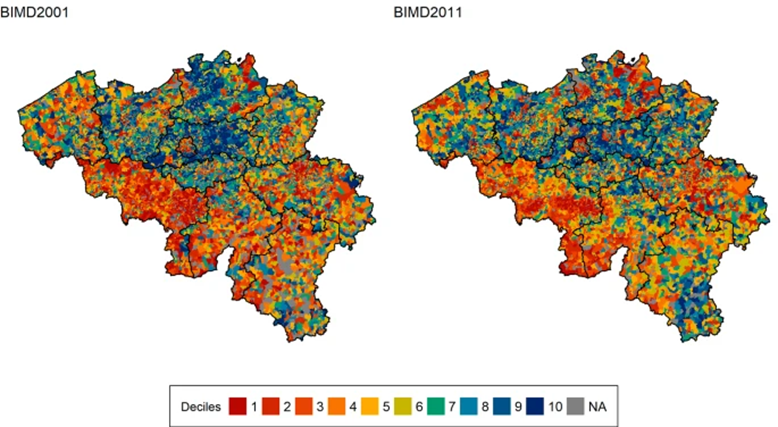1. Key messages
- The Belgian Index of Multiple Deprivation (BIMD) is a new multidimensional tool for measuring geographical variations in social and economic circumstances in Belgium.
- Premature mortality rates were significantly higher in the most deprived areas, with men experiencing rates 2.15 times greater and women 1.90 times greater than those in the least deprived areas in 2014-2019.
- Overall, premature mortality declined but health inequalities in area deprivation have widened over time.
- If there were no inequalities in area deprivation in Belgium, it is estimated that 29% of premature deaths among men and 25% among women could have been prevented between 1998 and 2019.
2. Belgian Index of Multiple Deprivation (BIMD)
The Belgian Index of Multiple Deprivation (BIMD) captures social deprivation as the unequal distribution of social and economic conditions at the local level. Specifically, the BIMD combines nationwide data sources to measure relative differences between areas in six domains: education, employment, income, housing, crime, and health. Each area receives a BIMD score, ranking it from the most deprived to the least deprived and grouping it in 10 equal parts (deciles). The most deprived areas, represented by the first decile, include the 10% of statistical sectors with the greatest disadvantages in the available socio-economic resources. In contrast, the last decile represents the 10% least deprived sectors. The BIMD is available for municipalities and statistical sectors, which are the smallest administrative units in Belgium. To this date, the BIMD is available for the years 2001 and 2011 with a new version for 2021 being developed by the Health Information Service of Sciensano. An online interactive tool allows users to explore the deprivation distribution across Belgium as measured by the BIMD, providing valuable insights into where social inequalities exist.
BIMD2001 and BIMD2011 deprivation deciles across Belgian statistical sectors, with the most deprived statistical sectors falling into the first deprivation decile (dark red)
Source: Otavova et al. (2023) [1]
Premature mortality was greater in the most deprived areas than in the least deprived areas
Considerable inequalities in premature mortality (deaths occurring before age 75) exist between the most and least deprived areas in Belgium. Using the Belgian Index of Multiple Deprivation (BIMD), re-built without the health domain, these inequalities were examined over time. Across all causes of death, premature mortality rates were higher in the most deprived areas than in the least deprived areas. In the period 2014-2019, premature mortality was 2.15 higher in men and 1.90 higher in women in the most deprived areas than in the least deprived areas. Comparing the periods 1998-2003 and 2014-2019, results show that premature mortality decreased overall for most causes of death. However, in general, the rate of decrease was slower in the most deprived areas, leading to widening inequalities between areas over time. For some specific causes of death, such as intentional self-harm and chronic liver disease, relative inequalities between areas narrowed for men and women. This was primarily due to an increase in premature mortality in the least deprived areas during 2014-2019.
Reducing area deprivation could prevent 1 out of 4 premature deaths in Belgium
An estimated 29% of premature deaths among men and 26% among women between 1998 and 2019 could have been avoided if the area deprivation inequalities measured by the Belgian Index of Multiple Deprivation (BIMD) had not existed. The highest proportion of premature deaths attributable to area deprivation was observed among men aged 40-59 years, where approximately 60% of these deaths could be attributed to inequalities. For women aged 40-54 years, more than 50% of premature deaths in the most deprived areas were similarly attributable to deprivation-related disparities. The causes of premature mortality most affected by area deprivation included psychoactive substance use, chronic lung disease, chronic liver disease, and diabetes, as presented in figure 2 (left).
Source: Otavova et al. (2024) [2]

Policy interventions to minimize area deprivation and social health inequalities
Developing and implementing a consistent and coherent focus to improve population health at the local, community, regional and national levels.
- Partnering with local organizations and communities in health promotion and resource allocation decisions to ensure actions and interventions are tailored to the specific needs and demographics of each area.
- Improving access to essential resources, including educational opportunities, stable employment, and financial assistance, for underserved groups, particularly in the more deprived areas.
- Strengthening all stages of health management in deprived areas by improving resources for prevention, diagnosis, treatment, and long-term care through targeted strategies such as health promotion initiatives and health education programs.
- Providing support and resources for families and caregivers in highly affected areas, particularly with regard to managing chronic illnesses and mental health issues.
3. Read more
References
- Otavova, M., Masquelier, B., Faes, C., et al. Measuring small-area level deprivation in Belgium: The Belgian Index of Multiple Deprivation. Spatial and Spatio-temporal Epidemiology 45 (2023).
- Otavova, M., Masquelier, B., Faes, C. et al. Trends in socioeconomic inequalities in cause-specific premature mortality in Belgium, 1998–2019. BMC Public Health 24, 470 (2024).
Please cite this page as: Sciensano. Factsheets: Belgian Index of Multiple Deprivation and cause-specific premature mortality, Health Status Report, 11 Dec 2024, Brussels, Belgium, https://www.healthybelgium.be/en/health-status/factsheets/belgian-index-of-multiple-deprivation-and-cause-specific-premature-mortality